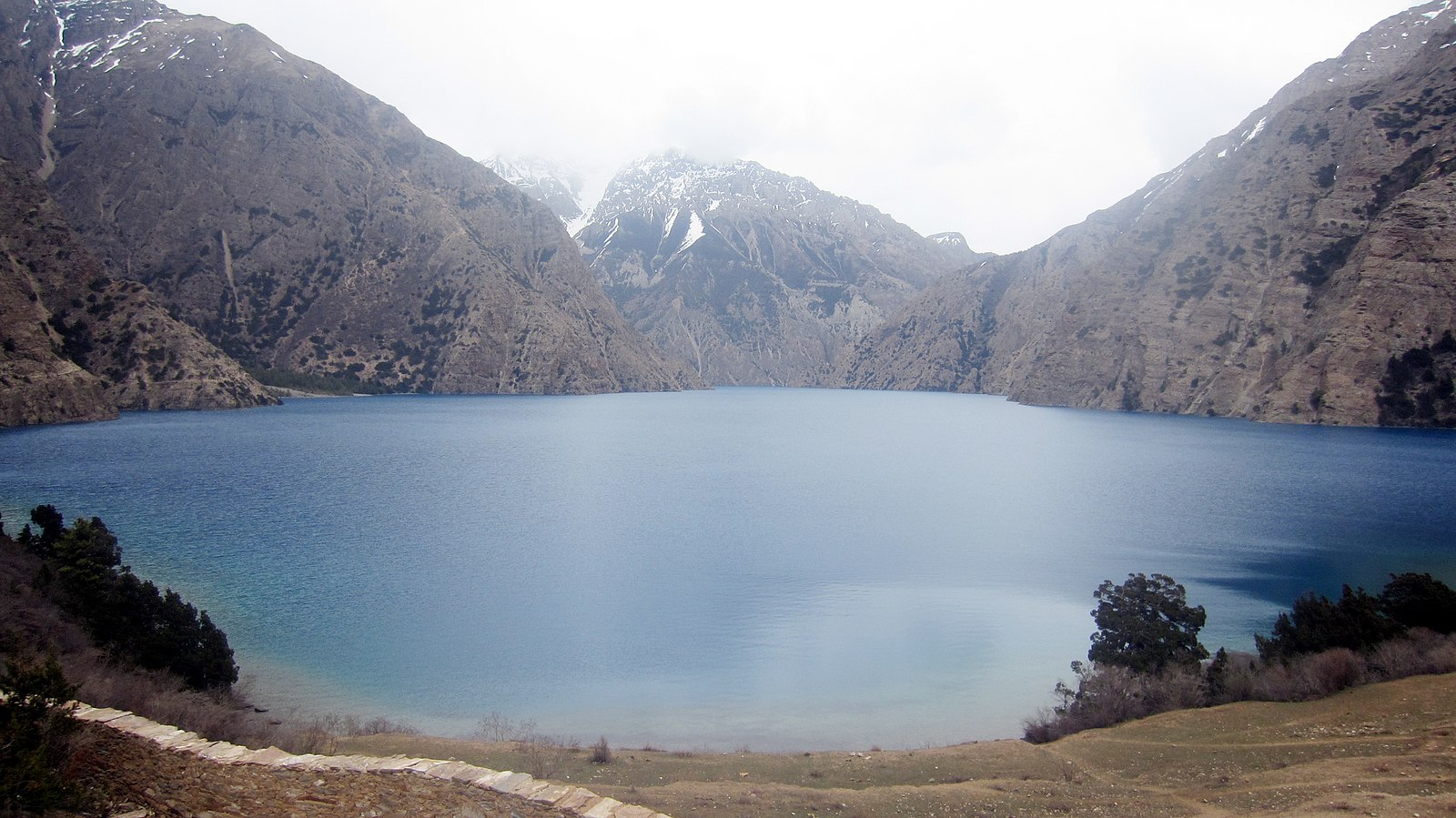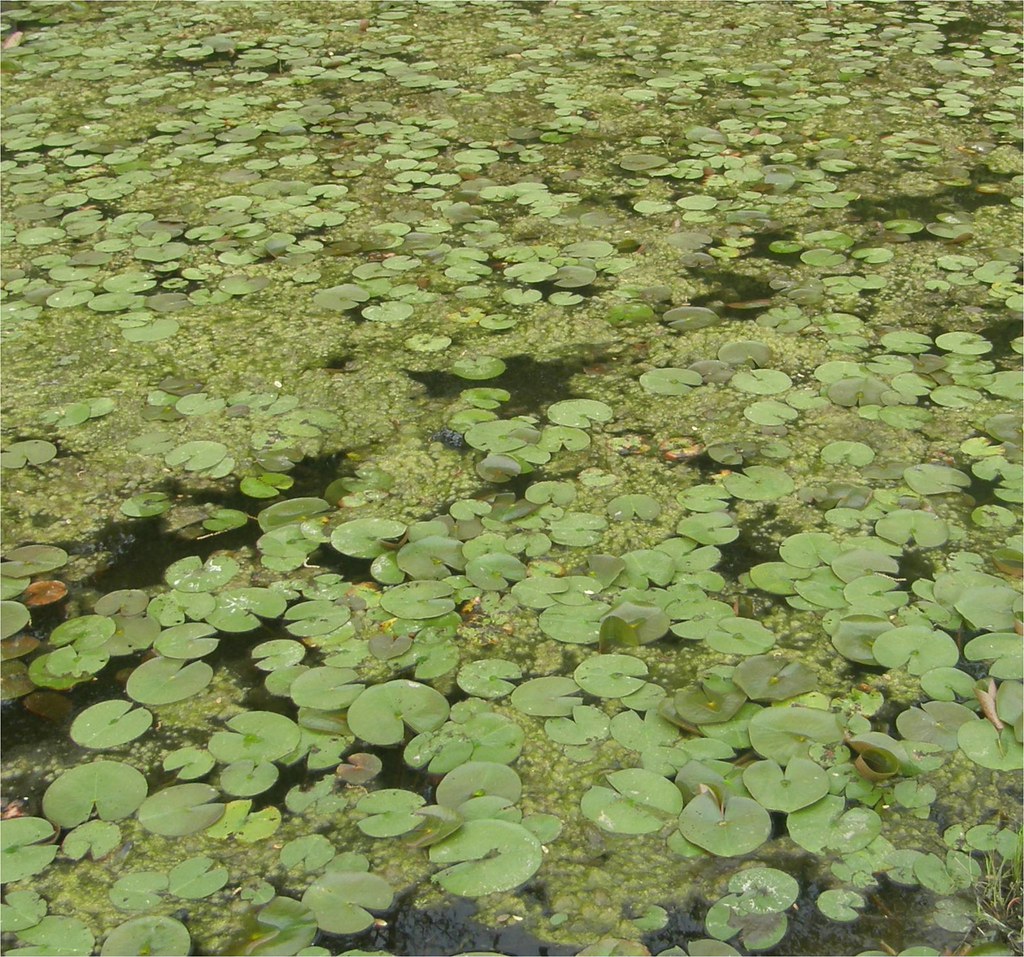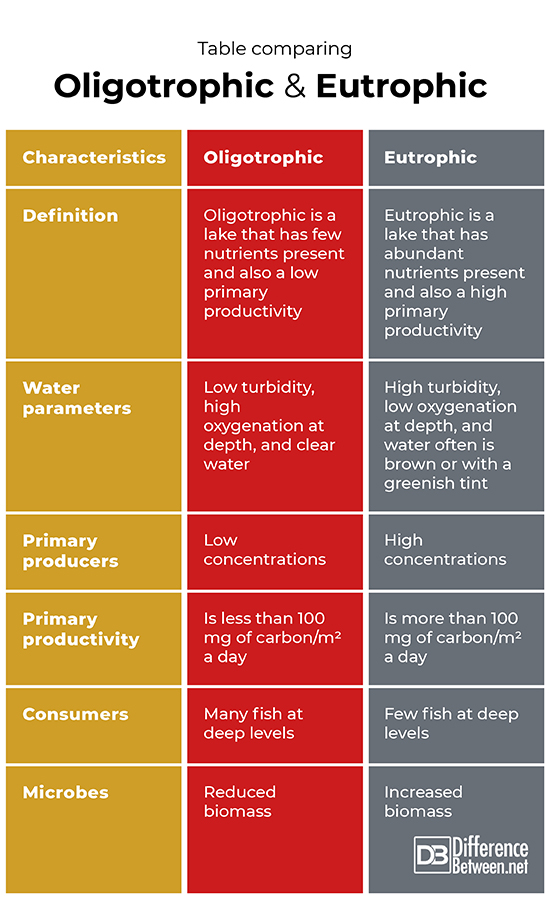Difference Between Oligotrophic and Eutrophic
Oligotrophic refers to a lake or dam in which primary productivity is at a low level due to a reduced quantity of nutrients. Eutrophic refers to a lake or dam where primary productivity is very high because of an abundance of nutrients.

What is Oligotrophic?
Definition:
Oligotrophic is a term used to describe a lake that has few nutrients present and thus, a low primary productivity.
Water parameters:
Water is usually clear, non-turbid or of very low turbidity in an oligotrophic lake. This allows light to penetrate to lower levels of the water and oxygen levels are also good because there are not a lot of algae covering the surface of the water, which would compromise light and oxygenation levels. Concentrations of elements such as nitrogen and phosphorous would be on the low side in such a lake.
Primary producers:
Oligotrophic lakes typically have few photosynthetic organisms present, in other words, there are few algal species or plant life present. These are also known as primary producing organisms since they produce sugars through photosynthesis and form the base of food chains and food webs in ecosystems. Primary productivity is less than 100 mg of carbon/m2 a day in an oligotrophic lake.
Consumers:
The consumers present in an oligotrophic system often differ from those of a eutrophic system because the water factors are different and there are fewer of the primary producers that are the source of food for primary consumers. However, many larger size fish, such as trout, which are found at greater depths, are more abundant because oxygenation is high at low levels in these lakes.
Microbial fauna:
Bacteria occur in low concentrations in oligotrophic waters. The biomass of bacteria is often one quarter that of oligotrophic lakes, probably because of the decreased nutrients present. Some bacteria may also fall into the primary producer category which is much lower in these water bodies.

What is Eutrophic?
Definition:
A eutrophic lake is one that is of high primary productivity due to an abundance of nutrients in the water.
Water parameters:
Eutrophic lakes are turbid with water that is not clear and may be a brown color as a result of high turbidity levels. In addition, large algal blooms may also influence the water color causing a greenish tint. Algal blooms can mean a decreased ability for light to penetrate to lower levels of the water column and may compromise oxygen leading to anoxic conditions (low oxygen concentrations) at depth.
Primary producers:
Primary producing organisms are in abundance in a lake that is eutrophic. This is because the extra nutrients such as nitrogen increase growth and reproduction of such life forms. The high levels of nutrients can result in explosive growth of green algae and blue-green algae (cyanobacteria) which can blanket the surface of the water causing other problems such as reducing light levels at lower levels of the water column. Primary productivity is more than 100 mg of carbon/m2 a day in eutrophic systems. Some photosynthetic cyanobacteria that develop in very eutrophic lakes produce toxic substances that kill wildlife and livestock and may compromise human health as well.
Consumers:
There may be fewer large consumers present in a eutrophic lake than an oligotrophic lake because the oxygen concentration is often lower in the deeper water. This means that fewer big fish can survive at depths, particularly if there are vast algal blooms on the surface.
Microbial fauna:
Microbes, particularly bacterial fauna, occur in much larger quantities in eutrophic water bodies than in oligotrophic waters. The biomass of bacteria is often four times higher in such lakes compared with oligotrophic lakes, probably because of the increased nutrients present. Some bacteria may also fall into the primary producer category which is increased in these lakes.
Difference between Oligotrophic and Eutrophic?
Definition
Oligotrophic is a term describing a lake with a trophic status in which there are few nutrients present and primary productivity is low. Eutrophic is a term describing a lake with a trophic status in which there are abundant nutrients present and primary productivity is high.
Water parameters
The water parameters of an oligotrophic lake are typically low turbidity, high oxygenation at depth, and clear water. The water parameters of a eutrophic lake are high turbidity, low oxygenation at depth, and water which is brown in color or with a greenish tint due to algal growth.
Primary producers
There are only low numbers of primary producers in oligotrophic lakes, none of which are toxic or produce toxic substances. There are high numbers of primary producers in eutrophic lakes, some of which are toxic and produce toxins.
Primary productivity
The primary productivity of an oligotrophic lake is less than 100 mg of carbon/m2 a day. The primary productivity of a eutrophic lake is greater than 100 mg of carbon/m2 a day.
Consumers
There are few fish at deeper levels in oligotrophic lakes. There are many fish at deeper levels in eutrophic lakes.
Microbes
The oligotrophic lakes have a reduced biomass of microbes present. The eutrophic lakes have an increased biomass of microbes present.
Table comparing Oligotrophic and Eutrophic

Summary of Oligotrophic Vs. Eutrophic
- Both eutrophic and oligotrophic are terms that are used to describe water bodies, particularly lakes and dams.
- Oligotrophic lakes have fewer nutrients than eutrophic lakes which mean that primary productivity is lower, but water clarity and oxygenation is better.
- Eutrophic lakes are those waters which have excess amounts of nutrients leading to high primary productivity, which at extremes leads to low light levels and low oxygenation levels.
- Difference Between Rumination and Regurgitation - June 13, 2024
- Difference Between Pyelectasis and Hydronephrosis - June 4, 2024
- Difference Between Cellulitis and Erysipelas - June 1, 2024
Search DifferenceBetween.net :
Leave a Response
References :
[0]Hessen, Dag O. "The relation between bacterial carbon and dissolved humic compounds in oligotrophic lakes." FEMS Microbiology Ecology 1.4 (1985): 215-223.
[1]Hessen, Dag O. "The relation between bacterial carbon and dissolved humic compounds in oligotrophic lakes." FEMS Microbiology Ecology 1.4 (1985): 215-223.
[2]Smith, Val H. "Eutrophication of freshwater and coastal marine ecosystems a global problem." Environmental Science and Pollution Research 10.2 (2003): 126-139.
[3]Williams, William D. "Inland water ecosystem". Encyclopedia Britannica, 2020, https://www.britannica.com/science/eutrophication
[4]Image credit: https://live.staticflickr.com/3607/3487323815_868e2ba632_b.jpg
[5]Image credit: https://commons.wikimedia.org/wiki/File:Phoksundo_Lake_Full_View.JPG
